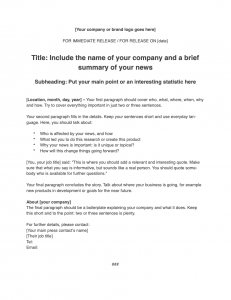Knowing how to write a press release is an important skill for any small business owner.
Press releases are the industry standard way to send official news, announcements and statements out to the media. Usually clocking in at a couple of hundred words, a good press release explains everything the journalist needs to know and provides a jumping-off point for an article. By learning how to write one you can take publicity into your own hands and make sure your message gets out there.
Why Are Press Releases Important?
Public relations legend Ivy Lee is thought to have invented the press release in 1906 following a fatal train accident in Atlantic City, New Jersey. Rather than trying to keep the story under wraps, Lee realised that he could take control of the situation and prevent hearsay from spreading by releasing an official statement from the rail company. It worked: the New York Times published his statement to the letter and companies have been doing it ever since.
The rise of digital media means that journalists have more news to cover than ever before. It’s much easier to get in touch with writers, but they have limited time to research and write about you. A press release lays out everything they need to know about the story and why it’s worth reporting on.
It’s increasingly common for outlets to publish press releases word-for-word, so you should take the time to write a release that’s factually accurate, makes sense and tells the reader everything you want them to know about your business.
How Are Press Releases Issued?
Press releases used to be sent on official letterhead. Today, it’s common practice to paste your copy directly into the body of an email, blind copying in the recipients. Avoid sending documents as most reporters won’t open them and they don’t come up when searching inboxes.
When composing your email, use common sense. Include a couple of high-resolution images, but don’t fill the recipient’s inbox. Consider providing a link to your press kit on Google Drive if you have a lot of images. Make the subject line your headline, and keep things simple.
If you have specific contacts at an outlet, sending individual emails with a personal note goes a long way. Place your greeting and signature above the press release and make the entire email as clear and easy to read as possible.
How to Structure a Press Release

Traditionally, there are nine standard elements to a press release:
- Your letterhead or logo
- ‘For Immediate Release’ or embargo details
- Headline and subheadline
- Date and location
- Body
- Quote
- Boilerplate
- Press contact information
- ### or –end–
We’ll address these step by step. Click here to download TechRound’s customisable template (.doc file), complete with notes on how to use it.
How to Write a Press Release—in 10 Steps
1. Set the context
Your brand, whether the information is embargoed and why you’re writing should all jump out immediately. As a rule, you should start with your logo, place ‘FOR IMMEDIATE RELEASE’ or the date information can be published directly after, then go straight into your headline.
2. Tackle the Five Ws
Cast your thoughts back to English lessons and you should remember the five Ws: who, what, when, where and why. You should be able to answer these questions in one or two sentences. If relevant, you should also explain how. It’s essential that your reader knows exactly where you’re going with this—don’t bury the lede!
3. Expand on the story
Your second paragraph should be another two or three sentences long and add context to what you’ve just written. Think about:
- Who does your news concern, and why?
- Why is this newsworthy? Have you solved a problem or discovered something interesting?
- Why is your business interested in this area?
- How will this affect things going forward?
4. Include a quote
After sharing the main bulk of the story, you should add a snippet of commentary from a founder or other representative. Keep quotes a couple of sentences long and always give the speaker’s full name and job title. Try to make sure it sounds like something a real person would say, and where possible only quote people who are available for further comment.
5. Conclude your story, adding any final details
Outline any remaining information such as your product’s price and stockists, then look to the future. Does your business have anything else in development, or will you be setting new goals? How are you acting on the news you’ve just shared?
6. Optional: Add another quote
This is a good place to quote another person or organisation, for example, if you’re collaborating with another business. This quote should follow the same idea of recapping your story and hinting at the future.
7. Optional: Notes to editors
If there’s anything else editors should know, share it under this heading. Don’t rehash the news—this section is best used for historical context or for other things your business is known for.
8. Cap it off with a boilerplate
A boilerplate is usually found at the very end of a press release, and it provides a quick summary of your business or organisation. A good boilerplate is just a few sentences long and explains who you are, what you sell and any notable achievements.
9. Include contact details
Contact details should be for your company’s main press contact or representative. Always include a phone number, and be prepared to take calls out of hours and on short notice—journalists are working on a deadline and need answers quickly.
10. Mark the end of your press release
Use a clear marker such as three hashtags (###) or –end– to mark the end of your press release. While it might seem obvious to you that your press release is complete, this assures the reader that they have all the information they need.
Once you’ve finished filling your template out, it’s ready to go: simply paste it into your email client and the formatting should copy over.
Extra Tips for Writing Effective Press Releases
- Keep your copy tight: 300 words is enough for most stories.
- Make it clear why your story is newsworthy.
- Use plain language, avoiding technical jargon and corporate speak.
- If in doubt, explain acronyms or concepts.
- Don’t forget to caption images with the names of people and products.



